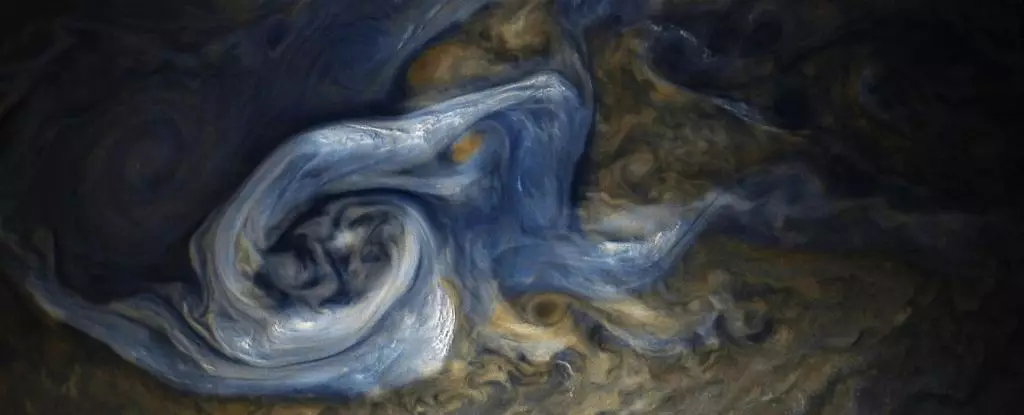When we think of the weather, we typically envision meteorological phenomena rooted in our own planet’s experiences—rain, snow, and thunder. However, the weather on Jupiter presents a dramatic and complex tapestry that challenges our understanding of atmospheric dynamics. A recent hypothesis has shed light on one of Jupiter’s most bizarre meteorological features: the phenomenon of “mushballs.” These intriguing clumps of ice, composed of ammonia and water, showcase the eccentricities of Jupiter’s atmospheric systems, highlighting that this gas giant is a fiercely active environment unlike anything found on Earth.
Understanding Mushballs
Imagine witnessing a colossal storm on Jupiter, where lightning cracks across dense clouds. Within these tumultuous tempests, it is theorized that mushballs, which resemble a slushy mixture of wet snow and ice, rain down. Research led by Chris Moeckel, a planetary scientist based at the University of California, Berkeley, has posited that during severe storms, frozen amalgamations of ammonia and water become airborne and collide, resulting in electrified clouds and, ultimately, precipitation in the form of mushballs. The peculiar makeup and behavior of these mushballs may hold the key to understanding the uneven distribution of ammonia within Jupiter’s atmosphere, leading to groundbreaking revelations about similar processes on other gas giants like Saturn, Uranus, and Neptune.
From Theories to Reality
Initially proposed by scientists who analyzed data from the Juno spacecraft, the mushball hypothesis has undergone rigorous examination. The Juno mission, which has provided invaluable insights into Jupiter’s atmosphere since its launch, gathered data during a lightning storm that continues to fascinate scientists. Through both Juno’s observations and those from the Hubble Space Telescope, Moeckel and his team have pieced together a complex blueprint of how storms operate at different altitudes. In their findings, they reveal that while surface-level phenomena seem apparent, much of Jupiter’s wild weather extends much deeper into its thick atmosphere, transforming the entirety of our knowledge about the planet.
The Mechanics Behind the Mushball Formation
Delving deeper into how mushballs form reveals a fascinating interplay of materials within the atmosphere. Water vapor, propelled upwards by powerful storm systems, encounters ammonia gas that lowers the melting point of ice. This unique condition allows droplets that are a mixture of ammonia and water to crystallize, creating the mushballs that descend back into the planet’s dense atmosphere. The combination of pressure and temperature at these vast heights allows for the development of these peculiar ice structures, which descend into the depths of Jupiter, potentially enriching its interior with compounds otherwise thought lost.
Astoundingly, these transporting mushballs are not merely a visual curiosity; they significantly alter the chemical makeup of Jupiter’s atmosphere. The research elucidates that as mushballs descend, they create a “unmixing” effect, redistributing ammonia through an otherwise stable atmosphere. This revelation not only enriches our understanding of Jupiter but also suggests that similar processes could be happening in the atmospheres of other gas giants, each brimming with its own mysteries yet to be unraveled.
Parallels Beyond Our Solar System
The budding field of exoplanet research is continuously unveiling worlds that challenge our preconceived notions of atmospheric dynamics. The mushball hypothesis raises tantalizing possibilities for the weather systems of exoplanets within distant solar systems. If the gas giants of our own solar system exhibit such unique and complex meteorological behavior, one can only imagine the atmospheric phenomena that might exist on planets orbiting other stars. The idea that mushballs could occur in similarly structured atmospheres could lead to new theories regarding their habitability or potential for supporting life.
Moreover, understanding Jupiter’s storms provides a foundation for exploring broader principles of atmospheric science. The mechanisms uncovered not only cast light on weather patterns unique to the gas giants but may also reveal comparative insights applicable to terrestrial storms on Earth. As we learn from the curious behaviors of Jupiter’s climate, we can better comprehend our own weather systems, unlocking the complexities of planetary atmospheres across the universe.
In Jupiter’s swirling clouds and thunderous storms, we find not only the essence of a celestial wonder but also the realization that our understanding of the universe is ever-expanding. The pursuit of knowledge may lead us to astonishing findings, urging a reevaluation of what we truly know about the planets that orbit our sun—and beyond.

